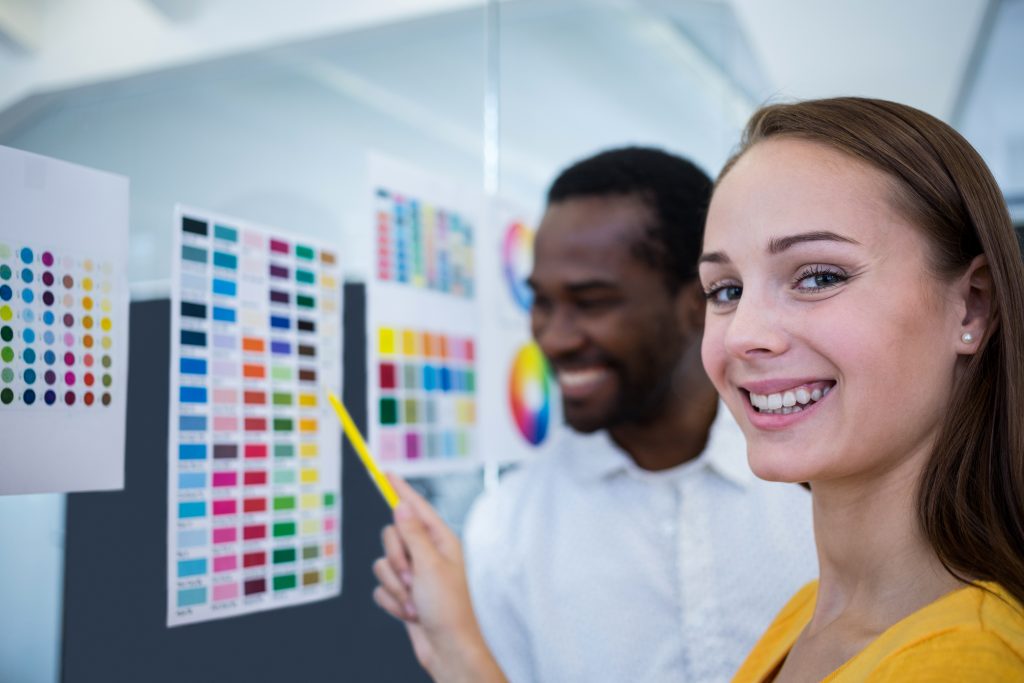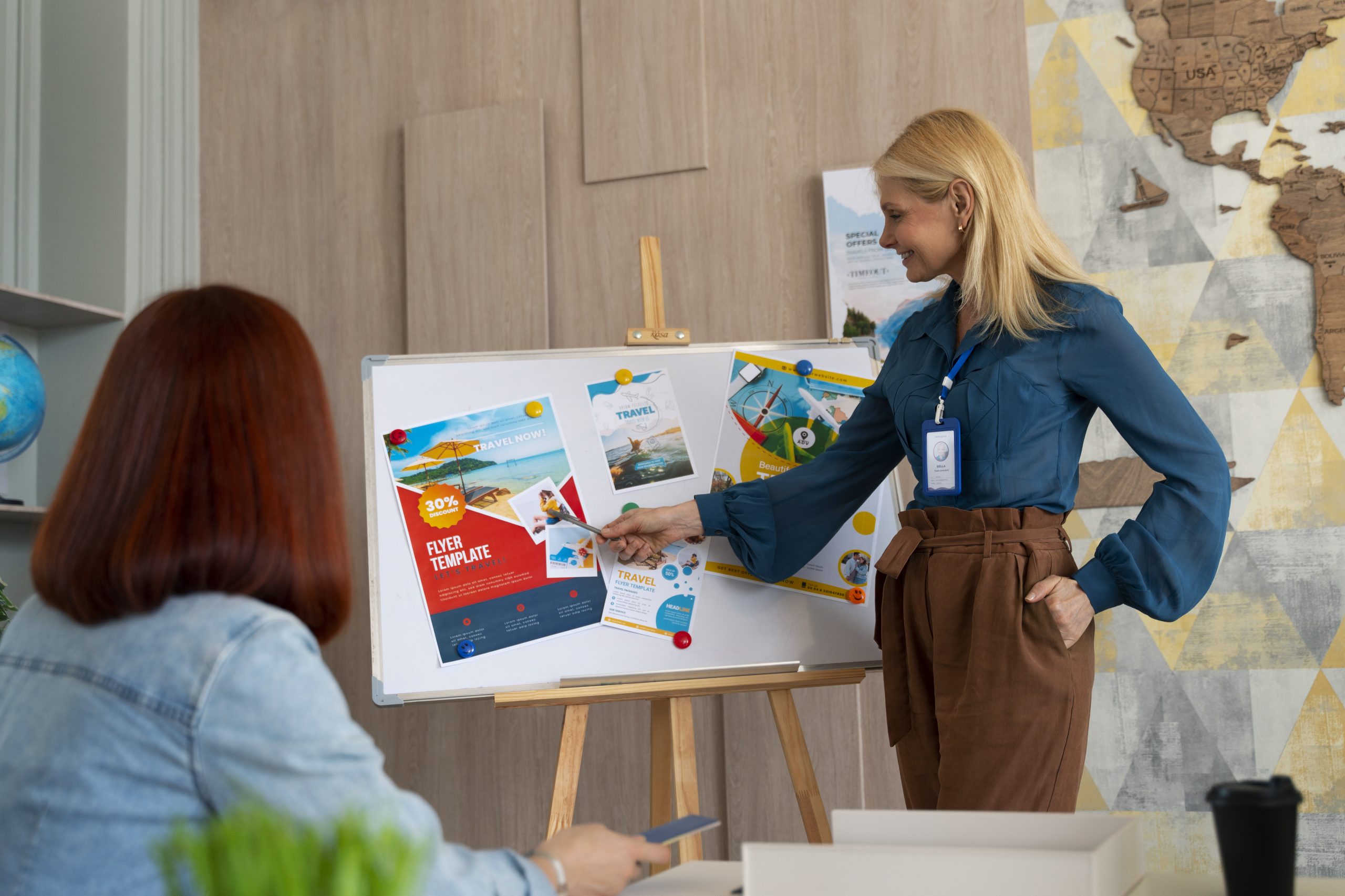Introduction:
Trade Shows- Printing for trade shows has become an essential component of modern marketing strategies, enabling businesses to make a lasting impact and captivate their target audience in a crowded exhibition space. Trade shows provide a unique opportunity for companies to showcase their products, services, and brand identity to a diverse range of industry professionals and potential customers. In this dynamic environment, where competition is fierce and attention spans are limited, the ability to stand out and leave a memorable impression is paramount. This is where effective printing solutions play a pivotal role.
The art of printing for trade shows goes beyond simply producing visually appealing materials. It involves a careful blend of creativity, strategic messaging, and high-quality production techniques to craft promotional materials that effectively convey a company’s value proposition and capture the attention of passersby. Whether it’s eye-catching banners, vibrant posters, informative brochures, or attention-grabbing signage, the right print materials can transform a trade show booth into a compelling and engaging experience.
From large-format printing that creates stunning visuals to interactive displays that captivate and educate, companies now have access to a vast range of tools to create immersive brand experiences. Leveraging these advancements allows businesses to differentiate themselves from competitors and create a lasting impact on attendees.
What is the correct colour space to use when printing a banner that will be placed on the wall of a trade show booth?
Many printing companies use the CMYK color set, which stands for cyan, magenta, yellow and black. These are combined to create all the colors your banner needs. However, the more colors that are added in, the better and more accurate the coloring can be.
When printing a banner that will be placed on the wall of a trade show booth, it is crucial to consider the correct color space to ensure optimal results. The most commonly used color space for printing is CMYK (Cyan, Magenta, Yellow, Black), which is the standard for four-color process printing. CMYK is ideal for capturing a wide range of colors and reproducing them accurately on printed materials. By using CMYK, the printer can create a combination of these four ink colors to achieve a full spectrum of hues.
When preparing the artwork for the banner, it is important to work in the CMYK color mode from the beginning. This ensures that the colors you choose will translate accurately when printed. Design software such as Adobe Photoshop or Adobe Illustrator allows you to work in the CMYK color space and make adjustments to ensure color accuracy.
It’s worth noting that using the RGB (Red, Green, Blue) color space, which is commonly used for digital displays like computer screens, may result in color discrepancies when printed. RGB has a wider color gamut than CMYK, meaning certain vibrant RGB colors may not be reproducible in print. Therefore, it is crucial to convert the artwork to CMYK before sending it to the printer to avoid any unexpected color shifts or inaccuracies.
To further ensure color accuracy, it is recommended to consult the printer’s color profile or request a proof before finalizing the printing process. A proof is a sample of the printed output that allows you to verify the colors and make any necessary adjustments before the final production.

What size are trade show banners?
With that said, the most common trade show banner sizes are as follows: 6×2 feet, 6×3 feet, 3×6 feet, and 2×6 feet. However, in most cases, you can work with a professional printing company to design custom-sized banners.
Trade show banners come in various sizes depending on the specific requirements of the trade show and the exhibitor’s booth space. While there is no standard size for trade show banners, some common sizes are widely used to ensure visibility and readability within the exhibition environment.
One popular size for trade show banners is 8 feet by 3 feet (8’x3′). This size offers a good balance between visibility and portability. It provides enough space to display key messages, graphics, and branding elements while being easily manageable and fitting within most booth spaces.
Another common size is 10 feet by 8 feet (10’x8′). This larger format allows for more expansive and impactful designs. It offers ample space to showcase product images, company information, and engaging visuals. These banners are often used for larger booth spaces or for businesses aiming to make a bold statement at the trade show.
What is a wholesale trade printer?
A trade printer provides wholesale printing to print resellers who sell to the ultimate client. A trade printer does not have contact with the reseller’s clients without the reseller’s permission.
Wholesale trade printers offer a wide range of printing services, including offset printing, digital printing, large-format printing, and specialty printing techniques. They typically have a diverse selection of printing equipment, advanced technology, and a skilled team of professionals to handle various printing needs. By leveraging economies of scale and specialized expertise, wholesale trade printers can offer competitive pricing and faster turnaround times to their reseller clients.
One of the key benefits of working with a wholesale trade printer is the ability to access a comprehensive range of printing options and customization choices. Resellers can offer their clients a wide array of printed products, such as business cards, brochures, flyers, banners, promotional items, and more, without the need for large-scale printing facilities or investments in equipment.
Wholesale trade printers also provide value-added services, including graphic design assistance, pre-press support, file preparation, and proofing, to ensure that the print projects meet the highest quality standards. They often have dedicated customer service representatives who can assist resellers throughout the printing process, from initial inquiries to final delivery.
For resellers and print brokers, partnering with a wholesale trade printer allows them to focus on marketing, sales, and client relationships, while leaving the printing and production tasks in the hands of experienced professionals. This collaboration enables resellers to expand their product offerings, deliver high-quality printed materials, maintain competitive pricing, and meet the diverse needs of their clients.

What is trade show displays?
“A trade show display is a highly visible statement about a company and its products,” said Laurie Pennacchi, vice president of sales at ExpoMarketing, a trade show display company. “The company benefits from having a display by attracting visitors at shows that generate leads.”
Trade show displays refer to the physical structures and visual elements used to showcase a company’s products, services, and brand identity at trade shows, exhibitions, and other industry events. They are designed to attract attention, engage attendees, and effectively communicate key messages. Trade show displays come in various forms, ranging from simple tabletop displays to elaborate, custom-built booth structures.
One common type of trade show display is the pop-up display. These displays consist of a collapsible frame that expands into a freestanding structure. They are lightweight, portable, and easy to set up, making them popular choices for exhibitors who require flexibility and convenience. Pop-up displays often feature large fabric panels that can be printed with high-resolution graphics, allowing businesses to showcase their branding and promotional messages effectively.
These displays are constructed using a system of interchangeable components, allowing businesses to customize the layout and size according to their specific booth space. Modular exhibits are versatile and can be reconfigured for different events. They offer a more substantial and professional appearance compared to pop-up displays, with options for shelving, lighting, multimedia integration, and other features to enhance the visual impact.
How do you make an impact at a trade show?
- Plant a Living Wall. Want to make your booth really “come alive”?
- Invite a Celebrity. Your booth’s design or features doesn’t have to be the main attraction
- Use Holoportation
- Home Run Competition
- Give Them Chocolate
- Go Monochromatic
- Make Your Own Rug
- Create a Space Within a Space
Making a significant impact at a trade show requires careful planning, effective execution, and a strategic approach. Firstly, it’s essential to create an eye-catching and professional booth design that reflects your brand identity and attracts attendees’ attention. Utilizing engaging visuals, interactive displays, and high-quality promotional materials can help create a lasting impression.
Providing live product demonstrations, interactive presentations, or engaging activities can generate buzz and draw attendees to your booth. Another key aspect is fostering meaningful connections with visitors. Training your team members to be knowledgeable, approachable, and enthusiastic will help create a positive and engaging atmosphere. Encouraging your staff to actively listen to attendees, ask relevant questions, and provide personalized solutions can significantly impact potential customers’ perception of your brand.
Sharing engaging content, live updates, and behind-the-scenes glimpses can pique the interest of those unable to attend while enhancing your overall presence. Lastly, following up with leads and contacts promptly is crucial to sustaining the impact made at the trade show. Sending personalized follow-up emails, making phone calls, or scheduling meetings demonstrates professionalism and can convert leads into long-term customers or partners.

What are the latest trends in printing technology for trade shows?
The printing technology landscape for trade shows is constantly evolving, adapting to the changing needs and preferences of exhibitors and attendees. Several exciting trends have emerged in recent years, transforming the way print materials are utilized in trade show environments.
On-demand printing, on the other hand, offers the flexibility to produce printed materials in real-time, eliminating the need for large pre-printed quantities and reducing waste. Another significant trend is the incorporation of interactive and immersive elements into print materials. Augmented reality (AR) and QR codes have gained popularity, enabling attendees to scan printed materials and access additional digital content, such as product demonstrations, videos, or interactive experiences.
This blending of physical and digital elements enhances engagement and creates memorable experiences for trade show participants. Additionally, sustainability has become a key focus in printing technology for trade shows. Exhibitors are increasingly opting for eco-friendly printing practices, utilizing recycled or biodegradable materials and adopting energy-efficient processes. The use of soy or vegetable-based inks and environmentally friendly coatings is also on the rise.
This shift towards sustainability aligns with the growing emphasis on corporate social responsibility and eco-consciousness. Lastly, advancements in large-format printing have revolutionized the visual impact of trade show displays. High-resolution graphics, vibrant colors, and innovative printing techniques like UV printing and dye sublimation have elevated the quality and aesthetics of banners, backdrops, and signage. These advancements enable exhibitors to create stunning visuals that captivate attention and effectively communicate their brand messages.
How can businesses leverage interactive print displays to engage trade show attendees?
Businesses can effectively leverage interactive print displays to engage trade show attendees and create memorable experiences that leave a lasting impression. Interactive print displays combine the tactile nature of print materials with digital elements, resulting in a unique and immersive experience for attendees. One way businesses can utilize interactive print displays is through the integration of augmented reality (AR) technology. By incorporating AR markers or QR codes into printed materials such as brochures or banners, attendees can use their smartphones or tablets to scan the codes and unlock additional digital content.
This content can include 3D product models, interactive demos, videos, or interactive games that provide a deeper understanding of the products or services being showcased. This interplay between the physical and digital realms enhances engagement and creates a dynamic and interactive environment. Additionally, businesses can leverage interactive print displays by incorporating touch-sensitive technology into their printed materials. This can be achieved through the use of conductive inks or touch-sensitive overlays.
Attendees can interact with the displays by touching specific areas or buttons, triggering different responses such as information pop-ups, product comparisons, or interactive quizzes. This hands-on approach encourages active participation and fosters a sense of discovery and exploration. Furthermore, businesses can use interactive print displays to gather valuable data and insights about attendees. By incorporating registration or survey forms within the interactive displays, businesses can collect contact information, preferences, or feedback, which can be used for follow-up communication and lead generation.

What are some tips for maximizing the impact of print materials at trade shows?
Maximizing the impact of print materials at trade shows requires careful planning and strategic execution. Here are some valuable tips to consider for businesses looking to make the most of their print materials in a trade show environment. Firstly, it is essential to ensure that the design and messaging of print materials align with the overall brand identity and marketing objectives. Clear and concise messaging, coupled with visually appealing graphics, will help attract attention and communicate key information effectively.
Utilizing high-quality images, vibrant colors, and professional printing techniques will further enhance the visual impact of the materials. Secondly, considering the target audience is crucial. Tailoring the content and design of print materials to resonate with the specific needs and interests of trade show attendees will increase their relevance and engagement. Incorporating interactive elements, such as QR codes or augmented reality markers, can create a memorable and immersive experience for visitors.
Thirdly, strategically placing print materials throughout the booth or exhibit space is vital. Displaying materials at eye-catching heights or incorporating them into interactive displays will increase their visibility and accessibility. Ensuring that the layout of the booth facilitates easy access to print materials will encourage attendees to engage with them. Additionally, it is beneficial to have ample quantities of print materials available to meet demand. Running out of materials can lead to missed opportunities and leave a negative impression. Lastly, integrating print materials with other marketing channels is essential for a cohesive and impactful presence.
Conclusion:
Printing for trade shows is a powerful tool that enables businesses to make a lasting impact on their target audience. By strategically designing and producing high-quality print materials, companies can differentiate themselves from competitors, captivate attendees, and effectively convey their brand message. The advancements in printing technology have opened up a world of possibilities, allowing businesses to create immersive experiences and engage trade show visitors in innovative ways.
To maximise the effectiveness of printing for trade shows, it is crucial to consider the key elements of design, such as eye-catching visuals, compelling messaging, and cohesive branding.
When executed successfully, printing for trade shows can transform a booth into a magnet for attention and leave a lasting impression on attendees long after the event concludes.

